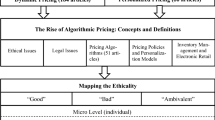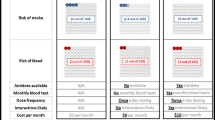Abstract
Although two-part tariffs are widely studied, only three papers consider three-part tariffs, which consist of an access fee in return for an allowance consumption level along with a unit “overage” price for consumption beyond the allowance. Moreover, none of these papers addresses some elementary and fundamental questions concerning the optimal features of the tariff in the presence of heterogeneous users: (1) How does the overage price (and thus marginal benefit for a high-demand user) compare to the marginal cost of the service? (2) How does marginal benefit compare to marginal cost for a low-demand user consuming at the allowance level? (3) How large is the access fee relative to benefits from the service? The purpose of this paper is to answer these questions by using a simple model with two types of consumers and a constant marginal cost. The analysis is carried out for a monopoly provider and then for the duopoly case, with the outcomes under the two market structures compared.

Similar content being viewed by others
Notes
Bagh and Bhargava (2013) show that a three-part tariff is superior to a two-part tariff without deriving its optimal features. Chao (2013) investigates interaction between two firms selling differentiated products, where the leader uses a three-part tariff and the follower uses linear pricing. Lambrecht et al. (2007) offer an empirical study of consumer choice under three-part tariffs.
While the price per unit of consumption below \(\overline{t}\) is fixed at zero, this restriction could be relaxed, allowing a positive price for units in this range different from the overage price. However, in order to match actual practice, in which a zero price prevails below \(\overline{t}\), the restriction is maintained.
Note that since \(D_L(p) < D_H(p)\), the inequalities in the lemma cannot hold as two equalities.
A generalization of the model would allow three consumer types, including a middle-demand group denoted M. It can be shown that the lemma still applies to type-L and type-H consumers, but that the type-M individual could consume either above or at the allowance level. Generalizing further, the model could have a continuum of demand types. In this case, there would exist a critical consumer type whose marginal utility would equal p at the allowance level, with higher (lower) demanders consuming above (below) \(\overline{t}\). F would determine a point in the demand continuum below which the service is not consumed.
If \(\overline{t}\) were absent, (10) would be a standard marginal-revenue-equals-marginal-cost condition, written in terms of price rather than quantity. The presence of \(\overline{t}\) means that marginal revenue only pertains to units above this level.
It is easy to show that the assignment where firm 1 serves only the H-types and firm 2 serves only the L-types is not an equilibrium. With neither type present in both firms, the relevant constraints are not equal-utility constraints (as discussed below) but instead are participation constraints. Moreover, the firms will rely only on access fees since they can fully extract the consumers’ surpluses this way (acting as local monopolists), with the F’s set so that the participation constraints are binding: \(u_H(\overline{t}_1) = F_1\) and \(u_L(\overline{t}_2) = F_2\). But since \(u_H> u_L\) holds, the H-types will then wish to move to firm 2, since their surplus rises from zero to \(u_H(\overline{t}_2) - F_2> u_L(\overline{t}_2) - F_2= 0\). Assignments where one firm serves just one of the types (H or L), with the other serving both types, can also be ruled out.
To prove the first inequality, the two utility constraints from below must be used separately to eliminate F in a profit function written analogously to (7), with the previous argument then applied. The second inequality is established by the earlier argument.
This approach, under which equal-utility conditions and zero-profit conditions for each type are imposed, is the appropriate way to extend Bertrand equilibrium analysis to the present case. These conditions allow the firm to choose the best combination of \(F,\ p,\) and \(\overline{t}\), holding utility constant at the level offered by the other firm, with the zero-profit conditions ensuring that no incentive exists to undercut the other firm by altering the three-part tariff to offer higher utility to one type.
Note that the conclusions in (28) hold whether or not the consumer mix is identical across the firms, as long as each type is present in both firms.
Note that, while the outcomes are equivalent, the standard Bertrand outcome cannot emerge as an equilibrium in the model given its setup, where the L-types consume at an allowance level that cannot be zero.
References
Baek, J. W. (2014). Three-part tariffs in monopoly and homogeneous-product duopoly. Unpublished paper, UC Irvine.
Bagh, A., & Bhargava, H. K. (2013). How to price discriminate when tariff size matters. Marketing Science, 32(1), 111–126.
Chao, Y. (2013). Strategic effects of three-part tariffs under oligopoly. International Economic Review, 54(3), 977–1015.
Gasmi, F., Moreaux, M., & Sharkey, W. (2000). Strategic nonlinear pricing. Journal of Economics, 71(2), 109–131.
Harrison, M., & Kline, J. J. (2001). Quantity competition with access fee. International Journal of Industrial Organization, 19(3–4), 345–373.
Jensen, S. & Sorgard, L. (2005). Two-part pricing, consumer heterogeneity and Cournot competition. SSRN working paper 900306.
Lambrecht, A., Seim, K., & Skiera, B. (2007). Does uncertainty matter? Consumer behavior under three-part tariffs. Marketing Science, 26(5), 698–710.
Oi, W. Y. (1971). A Disneyland dilemma: Two-part tariffs for a mickey mouse monopoly. Quarterly Journal of Economics, 85(1), 77–96.
Sundararajan, A. (2004). Nonlinear pricing of information goods. Management Science, 50(12), 1660–1673.
Yin, X. (2004). Two-part tariff competition in duopoly. International Journal of Industrial Organization, 22(6), 799–820.
Acknowledgments
We thank Jiawei Chen, Simon Loertscher, Larry White, and several referees for comments and suggestions. Any errors, however, are ours.
Author information
Authors and Affiliations
Corresponding author
Rights and permissions
About this article
Cite this article
Baek, J.W., Brueckner, J.K. Three-Part Tariffs with Heterogeneous Users: Monopoly and Duopoly Cases. Rev Ind Organ 47, 155–165 (2015). https://doi.org/10.1007/s11151-015-9471-2
Published:
Issue Date:
DOI: https://doi.org/10.1007/s11151-015-9471-2




